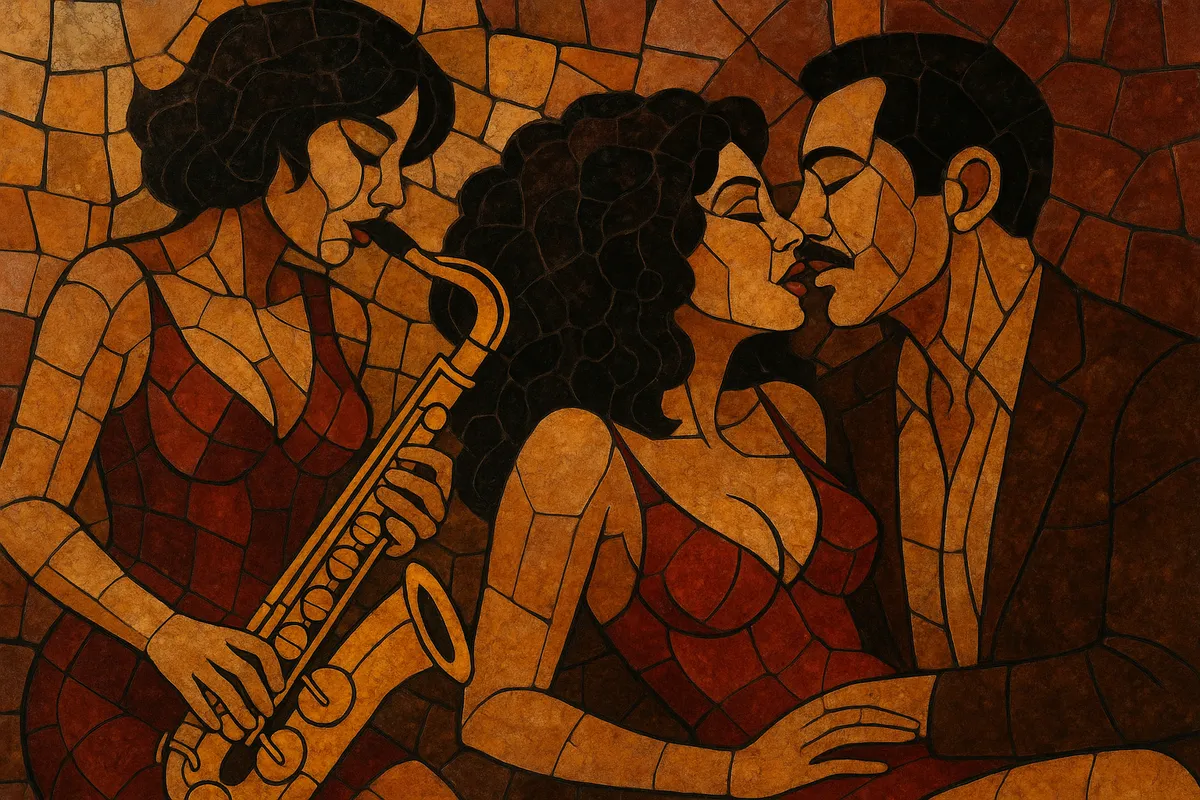
Porn groove is a sultry, tongue‑in‑cheek subset of 1970s funk, soul, and disco closely associated with adult film soundtracks and erotic exploitation cinema. It centers on slinky syncopated bass lines, wah‑wah and muted rhythm guitars, velvety Rhodes or Clavinet keys, syrupy string pads, and breathy saxophone or flute melodies.
Drums are typically soft yet insistent—either a lightly swung backbeat or a laid‑back four‑on‑the‑floor—with shakers, congas, and tambourine providing understated motion. Harmony leans on minor 7th chords and jazz‑soul extensions (9ths, 11ths, 13ths), lending a plush, nocturnal sheen. While often instrumental, cues may feature sparse spoken‑word ad‑libs, suggestive call‑and‑response riffs, and vamp‑based arrangements designed to sustain mood more than build drama.
Originally cut by session players and library‑music stalwarts for film cues, the style’s production aesthetic favors warm tape saturation, plate/spring reverbs, and close‑miked, intimate textures—conjuring an atmosphere that is both playful and suave.
Porn groove emerged in the United States during the early 1970s, the so‑called "Golden Age of Porn," when adult films briefly crossed into mainstream theaters. Low budgets and quick turnarounds meant producers often sourced music from library labels or hired small studio bands. The result was a sensuous hybrid of funk rhythm sections, soul‑jazz harmonies, disco’s steady pulse, and easy‑listening orchestrations.
While U.S. session musicians and library composers set the template, a parallel European current—especially in Italy and France—fed the style through erotica and sexploitation scores. Italian composers like Piero Umiliani, Stelvio Cipriani, and Nico Fidenco contributed lush, groove‑led cues that helped codify the genre’s iconic sound: wah‑wah guitars, Rhodes/Clav riffs, plush strings, and sultry reeds.
As adult cinema shifted from theaters to home video in the 1980s, production values and music budgets changed. The sound adapted, trading some live rhythm sections for drum machines and analog polysynths. Notable outgrowths include Patrick Cowley’s electronic scores for San Francisco’s gay adult films and Klaus Schulze’s Body Love albums, which translated the sensual groove into a hypnotic, Berlin‑school context.
Crate‑digging culture and reissue labels rekindled interest in library and soundtrack funk during the 1990s and 2000s. Trip hop, instrumental hip hop, and nu‑disco producers sampled or emulated the genre’s tactile rhythms, soft‑focus strings, and suggestive vamps. The "porn groove" signifier also became a pop‑cultural shorthand—used in comedy, advertising, and TV stings to instantly evoke playful sensuality.
Contemporary scenes like vaporwave, barber beats, and certain stripes of nu‑disco and lo‑fi beatmaking continue to channel the style’s plush sonics—warm tape saturation, Rhodes pads, muted guitars, and languid bass ostinati—recasting porn groove’s kitschy, luxurious aura for modern listening contexts.
Aim for 92–112 BPM. Choose either a lightly swung backbeat (funk) or a soft four‑on‑the‑floor (disco). Keep drums subdued but present: tight kick, gentle snare/brushes, closed‑to‑half‑open hi‑hats with 16th‑note embellishments, and light percussion (shakers, congas, tambourine) for continuous motion.
Use minor 7th chords with extensions (m9, m11, m13), dominant 9ths, and jazzy turnarounds. Favor vamp‑friendly progressions (e.g., i–iv, i–bVII, or ii–V–i in minor) that sustain mood. Craft a slinky, syncopated electric‑bass ostinato—think palm‑muted flatwounds, tight note lengths, chromatic approaches, and tasteful slides.
Layer Rhodes or Wurlitzer pads and short Clavinet riffs (syncopated 16ths). Add wah‑wah or muted rhythm guitar stabs, double‑stops, and gentle octaves. Consider small string sections (or string synth) for sustained pads and soft swells. Feature breathy sax or flute for melodic hooks; occasional vibraphone or mellow trumpet can enrich timbre.
Structure cues around 16–32‑bar vamps that introduce elements gradually. Use call‑and‑response between bass, guitar, and keys; insert short breakdowns (dropping to bass + percussion) and rebuild with strings or reeds. Keep sections long enough for scene coverage but varied via microrhythmic fills, filter sweeps, and orchestration changes.
Pursue warm, intimate sonics: tape or tape‑style saturation, gentle bus compression, plate/spring reverbs, and analog‑style delays. Pan guitars and keys for width; keep bass center and dry. Soften transients with saturation rather than heavy limiting. Aim for plush low‑mids, silky highs, and minimal harshness.
If used, keep vocals sparse: breathy ad‑libs, whispered lines, or wordless background coos. Treat them as texture, not a lead element, to preserve the cue’s suggestive, playful quality.

